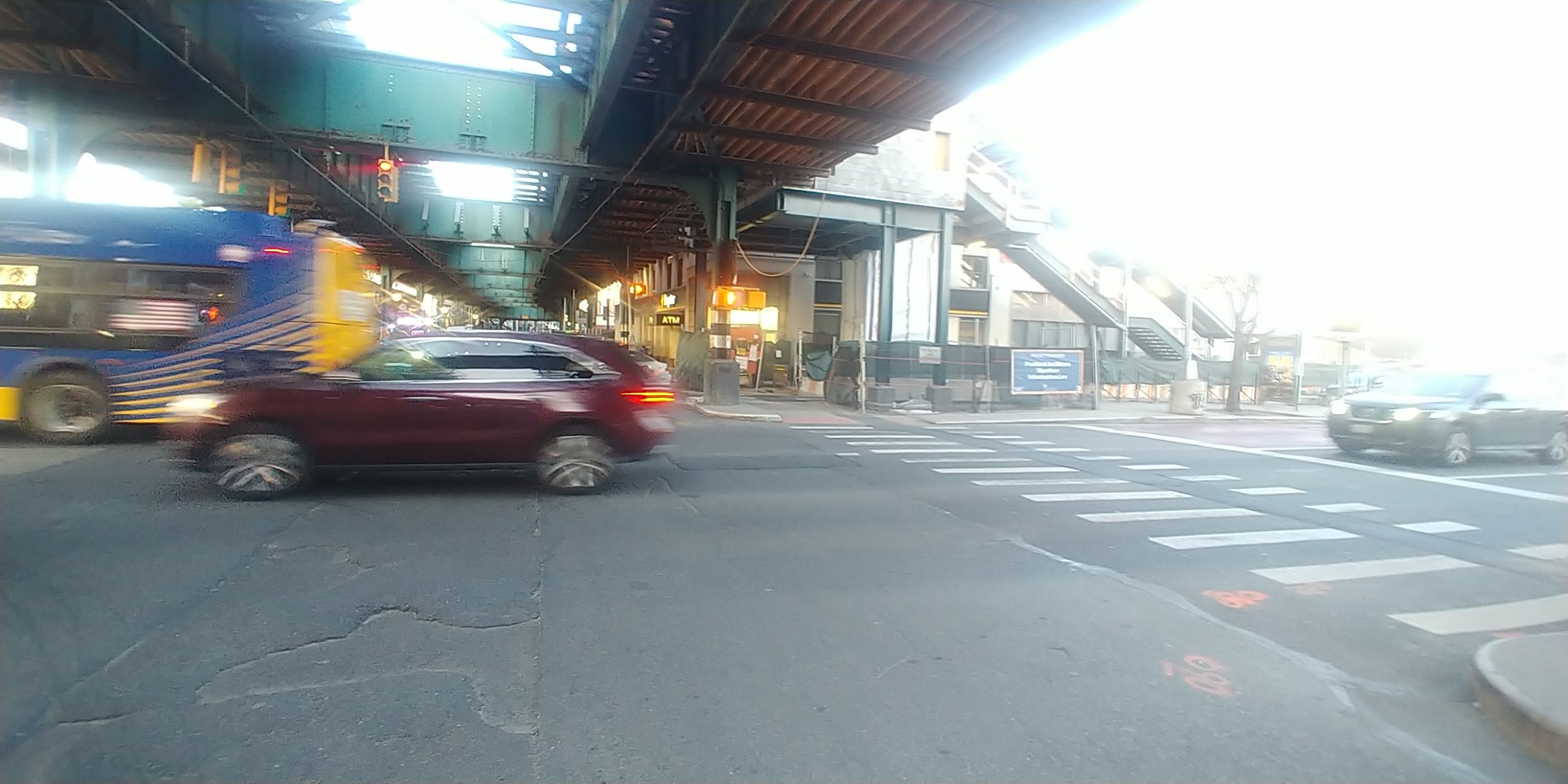
I don't recall ever seeing infrastructure upgrades honoring a president before. This looks like a campaign ad for The Big Guy.

I don't recall ever seeing infrastructure upgrades honoring a president before. This looks like a campaign ad for The Big Guy.

For months, members of Grace Episcopal Church in Jamaica have complained of being hit with traffic tickets when they drop off elderly people and those with limited mobility in front of the church on Jamaica Avenue, where the city’s Department of Transportation installed a busway in late 2021. Since then, parishioners have been working with area elected officials and the DOT to find a solution.
With tickets starting at $50 for parking in the busway and increasing up to $500 after several offenses, the cost has weighed on churchgoers. But part of the problem, says church vestry member Annette Manigault, was the lack of clarity on how the street and bus cameras ticketing drivers worked.
“We’re trying to make sure we can get the parishioners, especially our elderly or disabled, into the church, because no one was in knowledge of how the cameras are working, as well as the location being not accessible for cars coming down Jamaica Avenue,” she said.
She added that the nearest parking lots are several blocks away, making the need to drop off those with limited mobility all the more vital.
Under busway rules, no through traffic is allowed on Jamaica Avenue from Sutphin Boulevard to 168th Street, seven days a week from 6 a.m. to 8 p.m.; cars on the avenue must make the first available turn off of it.
In a recent walk-through of the site, which was attended by Queens Commissioner Nicole Garcia, the DOT clarified to parishioners that the busway does not prevent cars from accessing a given block of Jamaica Avenue — it tickets drivers from continuing down it for more than a block. Therefore, there are several ways churchgoers can drop off their loved ones in front of the church without facing tickets, as detailed in a DOT pamphlet the agency said it handed out at the walk-through.
If traveling south on Parsons Boulevard, drivers can turn right onto Jamaica Avenue, stop in front of the church, then turn right onto 153rd Street. Drivers coming from the east on Archer Avenue can turn right onto Parsons Boulevard before turning left onto Jamaica and making their drop off, then continuing onto 153rd Street. From the west, drivers on Archer Avenue can turn left onto 153rd Street and then right onto Jamaica Avenue. After stopping, they can turn right onto Parsons Boulevard and then right onto Archer again. The latter does, however, require churchgoers to cross the street.
During a Cambria Heights Civic Association Zoom meeting last Thursday, many residents aired their concerns about what will become of a defunct area Rite Aid, located at 222-14 Linden Blvd.
Throughout the online forum, several people said they had heard rumors that the new owner of the former pharmacy’s lot intends to transform the space into a transient shelter and worried that could destroy property values and create safety problems.
Under the city Department of Buildings certificate of occupancy, or CofO, Comments section, it was noted that “the facility shall be operated by a philanthropic or non-profit institution, sponsored by [the Department of Homeless Services] ... This certificate shall expire when the ownership operation and use by an institution or public agency ... ceases. The Class B multiple dwelling classification of this building is lodging house.”
DOB’s job filing data says there are no work permits filed, but the zoning information, scope of work and cost affidavit sections have proposals for a transient lodging house, which would include a community facility, a cafeteria and eight dwelling units for 120 beds. If the proposal were to go through, the project is expected to cost $607,170 in property alterations.
Bryan Block, the president of CHCA, said there were about 60 objections to the proposed project as of April 11.
Some of the objections to converting the space include a lack of egress, the parking layout, the elevation of the lot, the noncombustible rooftop hatch and whether the property was in a flood zone, according to DOB.
“The civic was not notified about this and nothing came to the community board,” said Block, “Yes, there was a rumor going around, but there was nothing filed until a couple weeks ago. So, when we said it was a rumor, it was because we didn’t have anything in writing from about three weeks ago. We don’t go on rumors, we go on what we get from the city and we still haven’t gotten anything from the city.”
The lot is zoned R3-2, which in general denotes residential districts that allow a variety of housing types, including low-rise attached houses, small multifamily apartment houses, and detached and semidetached one- and two-family residences. It is the lowest-density zoning district in which multiple dwellings are permitted in Queens, Brooklyn, Staten Island and the Bronx, according to the Department of City Planning.
“The site where the building is located is ... zoned residential, but it has a commercial overlay, which allowed the Rite Aid commercial use there,” said Steven Taylor, a CHCA board member. “The point I’m making is, they have the ability to make this for residential use even though we’ve always looked at it as a commercial use.”
The lot is 20,460 square feet, including the 10,000-square-foot commercial building and 30 parking spots. It is a six- to 11-minute drive from five Long Island Rail Road stations, the E,F, J and Z subway stations and the JFK AirTrain. It was put up for sale on Dec. 12, 2023 and sold for $5 million on Feb. 16, according to several real estate websites.
State Sen. Leroy Comrie (D-St. Albans) said seeking an injunction against the DOB to prevent a shelter from being erected in the space could be a possibility.
“I’m going to check with the councilmember if one has not been filed,” Comrie said.

Seventeen Eastern Queens civic leaders reiterated their opposition to the state’s redevelopment plan for much of the Creedmoor Psychiatric Center property last week after Borough President Donovan Richards touted it as a “community-led effort” in a newsletter.
Area civic groups oppose the plan because, they say, it will be too dense for the region, with buildings that are too tall and lack adequate parking, and that it will be too great a strain on existing infrastructure including roads and sewers.
Richards, who regularly speaks of the need for more housing in Queens and touts the projects slated to produce it, included an item headlined “A New Day is Dawning at Creedmoor” in a newsletter his office said was mailed to tens of thousands of homes across Queens last week. The missive was timed to follow his April 12 State of the Borough address.
“The largest community development project in the history of Eastern Queens is on the horizon in the form of Borough President Richards and Empire State Development’s draft Creedmoor Community Master Plan,” the piece says. “The community-led effort aims to redevelop 50 vacant acres of state land through the creation of more than 2,000 units of housing, with 55 percent being designated for homeownership.”
Empire State Development, the agency planning the project, has proposed 2,873 units of housing on 58 acres of the Creedmoor campus. The plan includes 813 elevator co-ops in buildings of six to eight stories, 536 walk-up co-ops in buildings of three to four stories, 186 triplexes in three-story structures and 98 semidetached two-family homes of two stories. There would be 377 senior homes, 431 supportive housing units and 432 apartments deemed affordable and granted by lottery, in buildings of six to eight stories.
The civic leaders said in a letter emailed to Richards on April 19 that they object to his calling the project “community-led,” since area neighborhood organizations do not support the plan and saw their own proposals for the property overridden.
They want a maximum of 1,000 units of two to three stories, and note that Community Board 13 passed a resolution to that effect.
“The plan by Empire State Development is not acceptable,” the civics’ letter says. “The layout is primarily four story, six story and eight story buildings, which are not compatible with our communities. In fact, except for one six story apartment building at 259th Street you will not find anything on the Hillside Avenue corridor from Winchester Boulevard to the city line higher than two stories.”
Not mincing words on what the @SienaResearch poll means for congestion pricing. pic.twitter.com/5Bjv96T6Ob
— Joe Borelli (@JoeBorelliNYC) April 22, 2024
New York voters overwhelmingly reject having to pay a new $15 “congestion” toll to enter Midtown Manhattan, a statewide poll released Monday shows.
The Siena College survey finds that 63% of voters throughout the Empire State oppose the toll, while only 25% support the pricing scheme promoted by Gov. Kathy Hochul and the MTA to curb congestion and generate nearly $1 billion a year to fund mass transit.
In New York City, 64% of voters are against the first-in-the-nation congestion pricing plan to enter the Manhattan business district south of 60th Street compared to just 33% who back it.
An even higher 72% of voters who reside in the suburbs surrounding the Big Apple — more likely to drive than take mass transit into Manhattan — oppose the controversial toll that the Metropolitan Transportation Authority could implement as early as June.
Opposition to the toll is one of the few issues that unifies all cross-segments of New York voters.
The new toll is opposed by 72% of blacks, 62% of Latinos, 62% of union households, 75% of Republicans, 69% of independent or unaffiliated voters, 75% of Republicans and even a majority 54% of Democrats.
Congestion pricing is being implemented because of a state law championed by former Gov. Andrew Cuomo and the Democrat-controlled legislature in 2019 — yet only 34% of Democrats support it.
Hochul, Cuomo’s successor, has defended congestion pricing as a good thing amid a plethora of lawsuits to block it.
“A majority of Democrats, two-thirds of independents and three-quarters of Republicans oppose the soon-expected congestion pricing toll plan, as do approximately two-thirds of downstaters and a majority of upstaters,” said Siena College pollster Steven Greenberg.
One in seven voters — 14% of respondents — said they would travel less to Manhattan to avoid the toll, while 17% said they would find another way to get to Midtown that could include mass transit.
Another 14% of respondents said the toll would have no effect on their travel patterns while 44% said they don’t go to Manhattan. The poll queried upstaters who rarely venture into the Big Apple.
Congestion pricing imposes a $15 toll on cars traveling anywhere below 60th Street between 5 a.m. and 9 p.m. on weekdays and 9 a.m. to 9 p.m. on weekends.
Overnight, the toll drops to $3.25.

